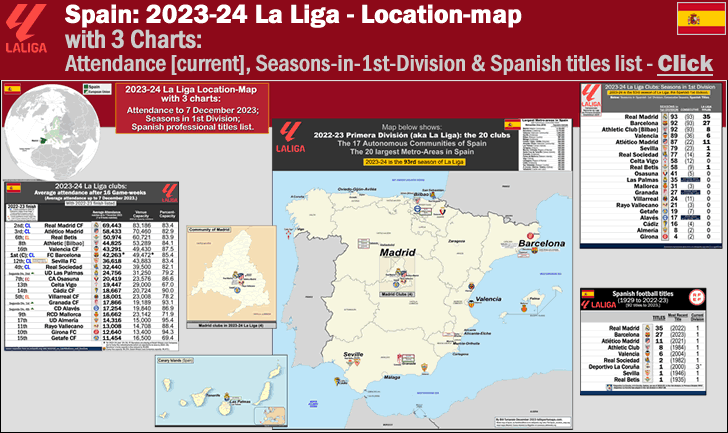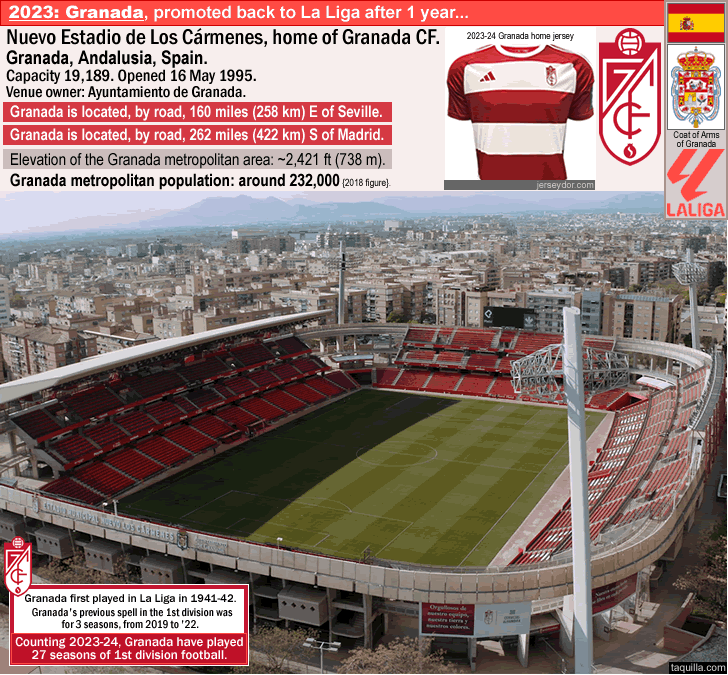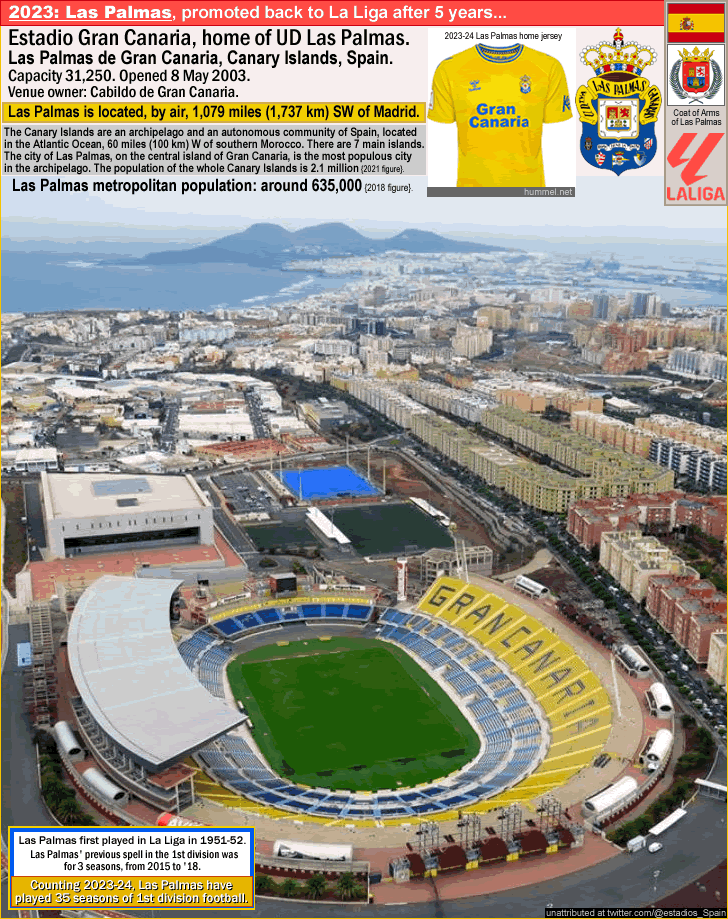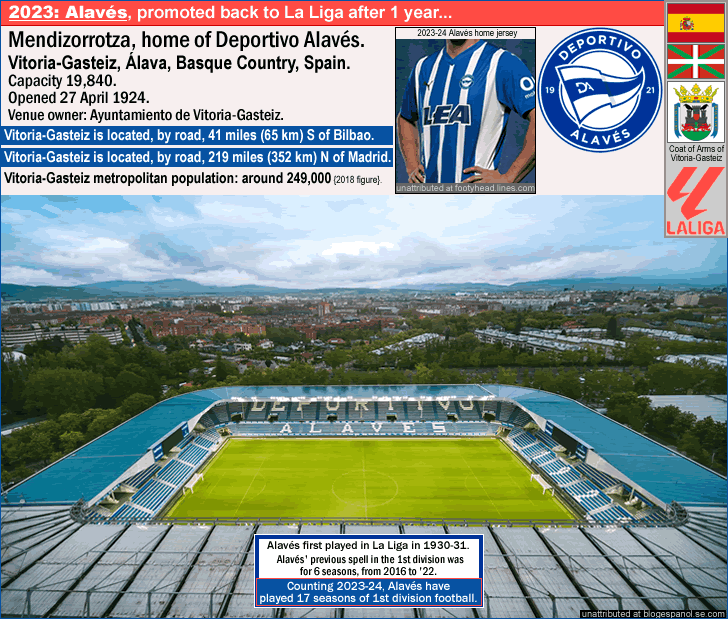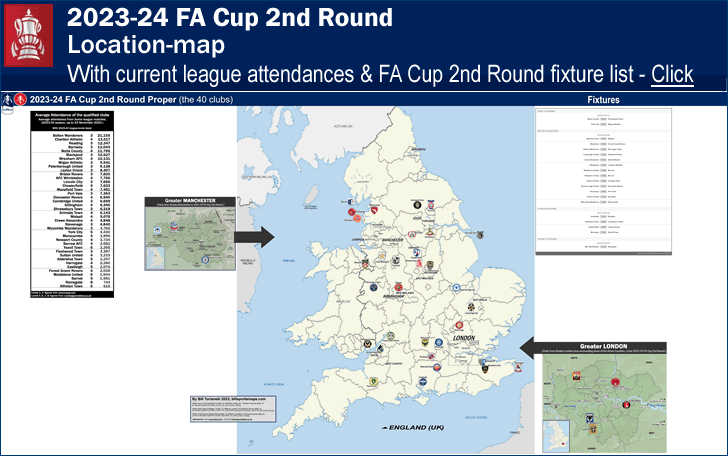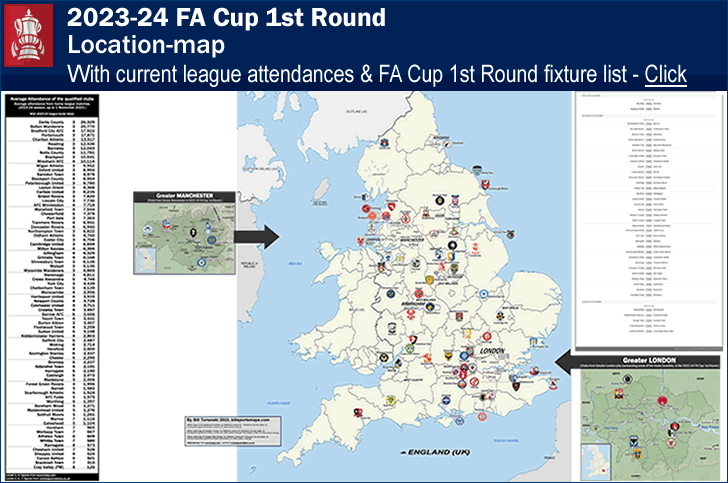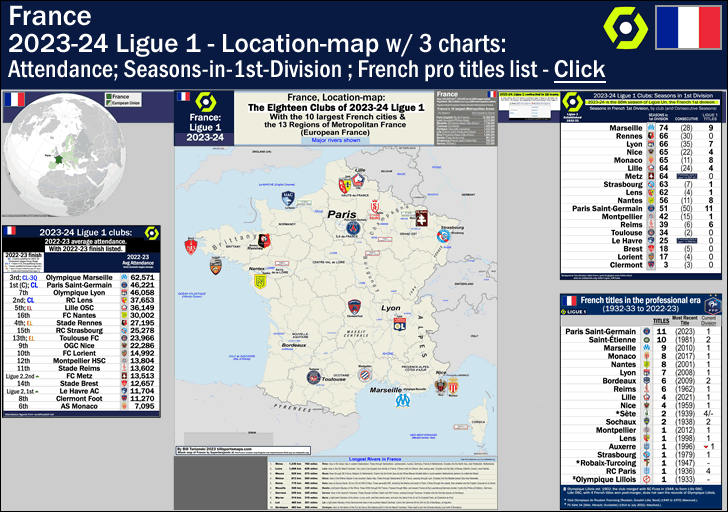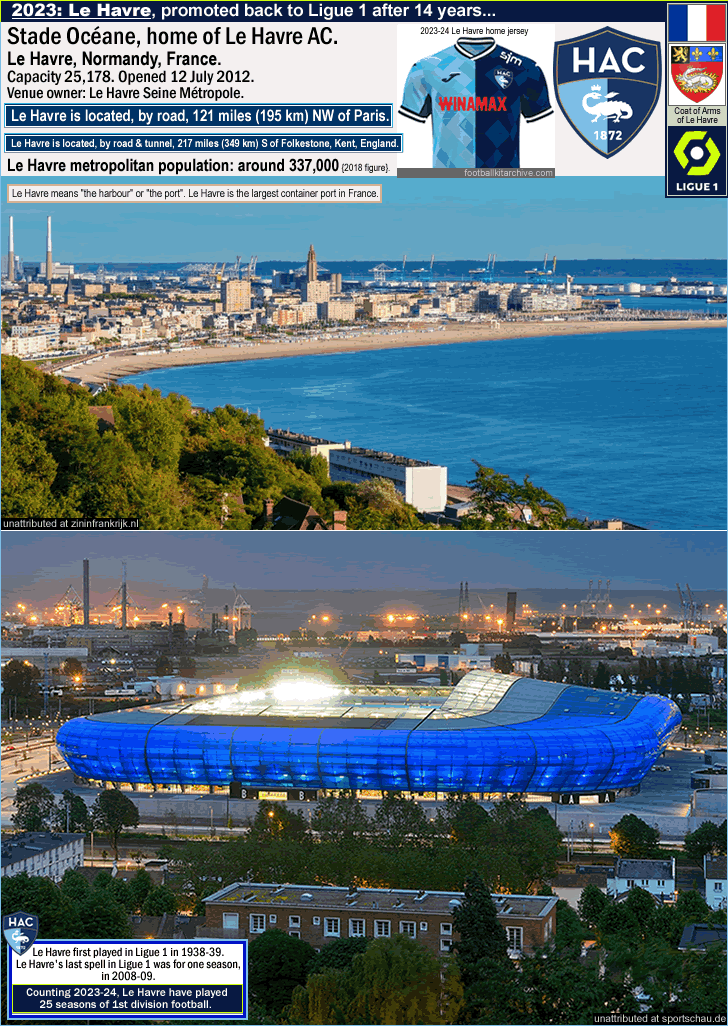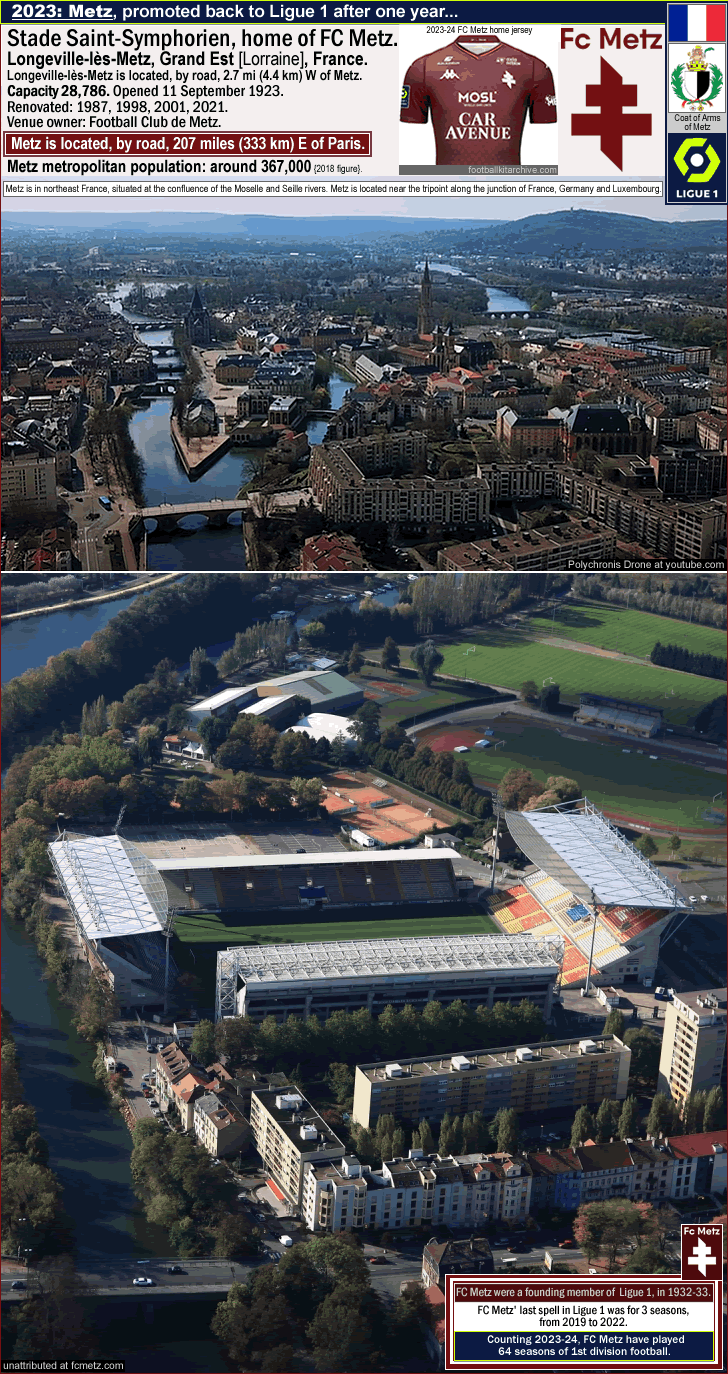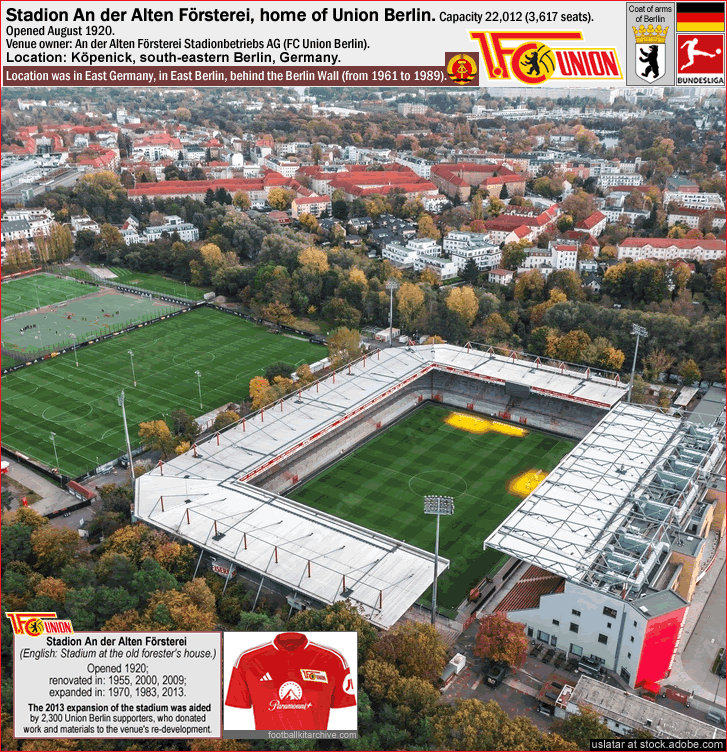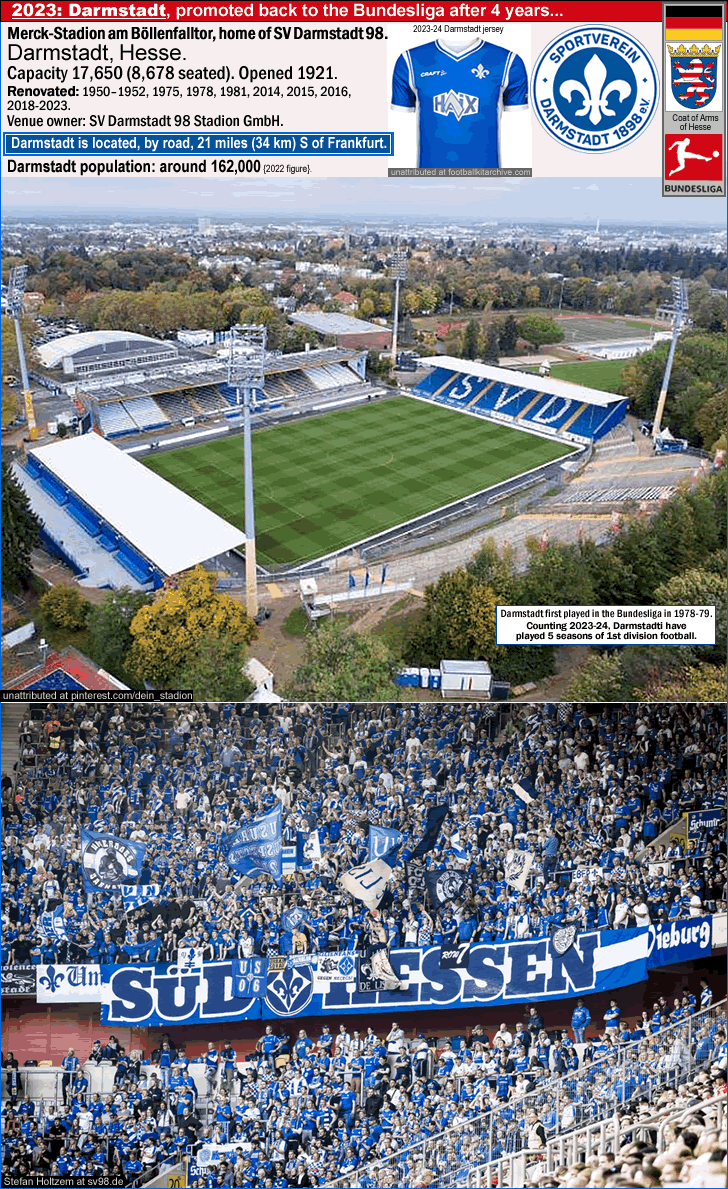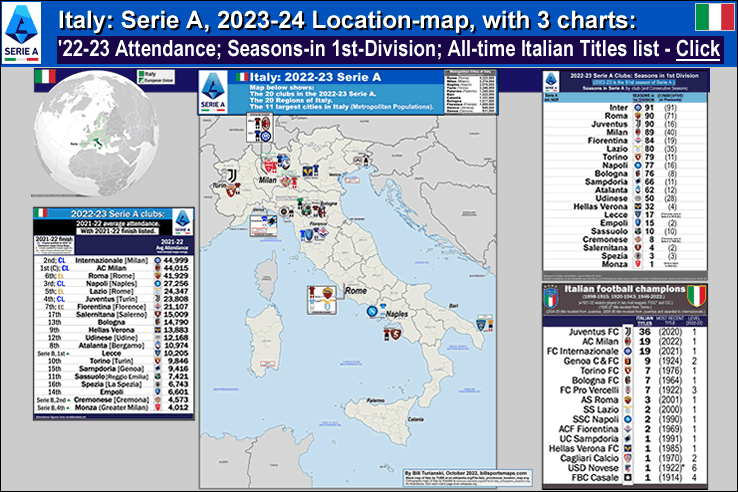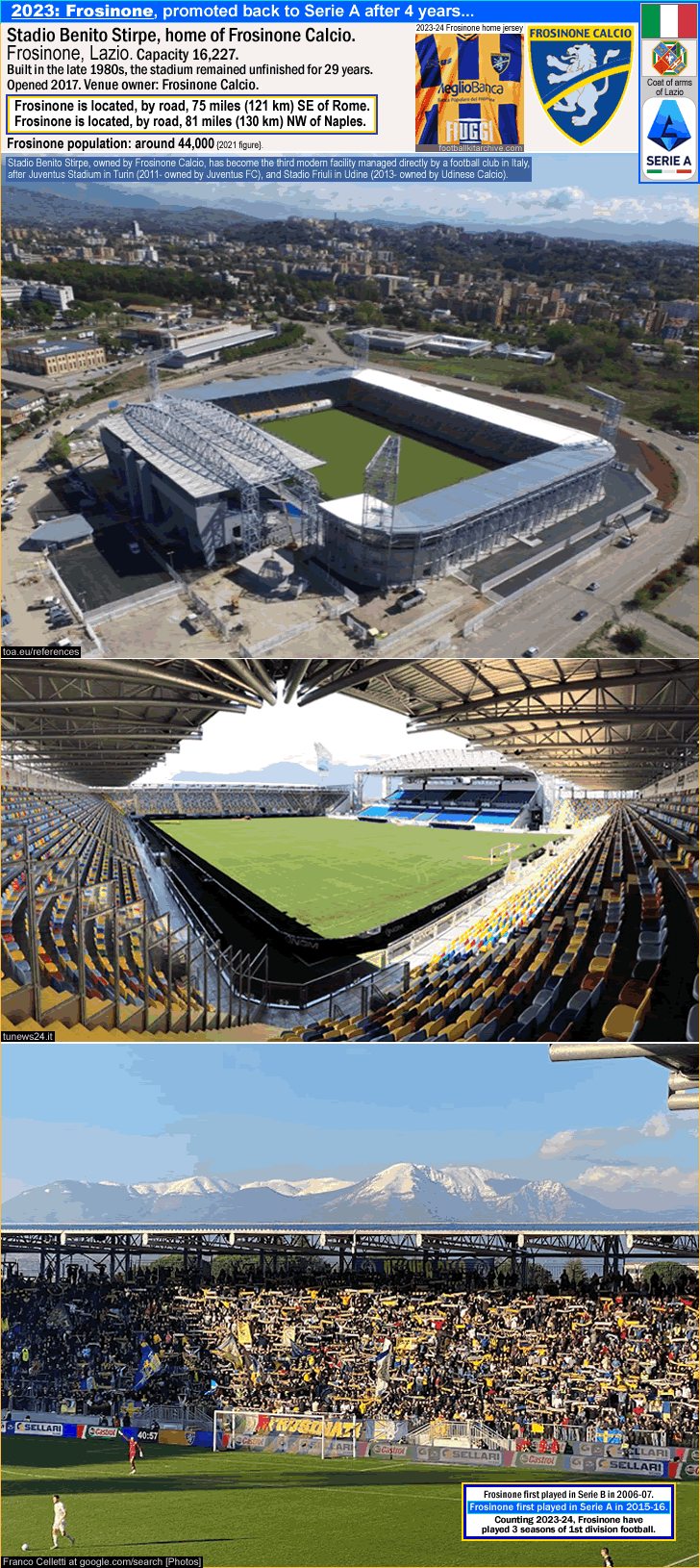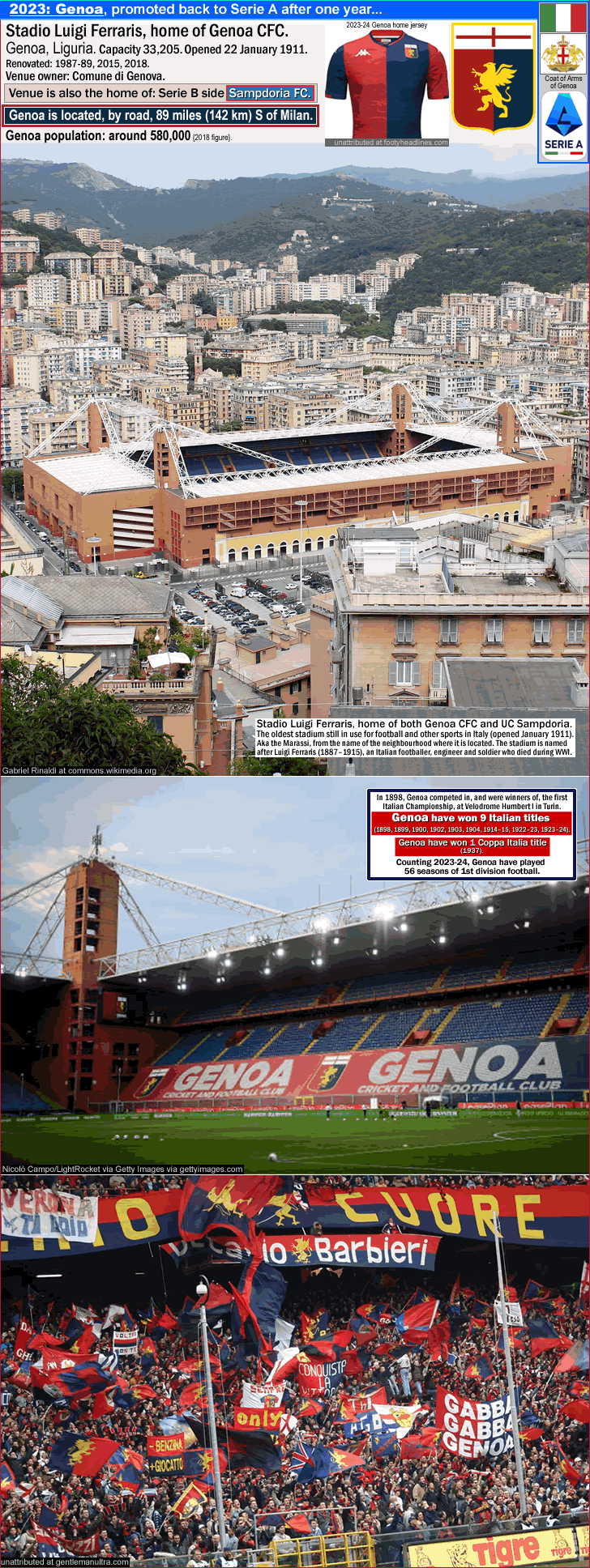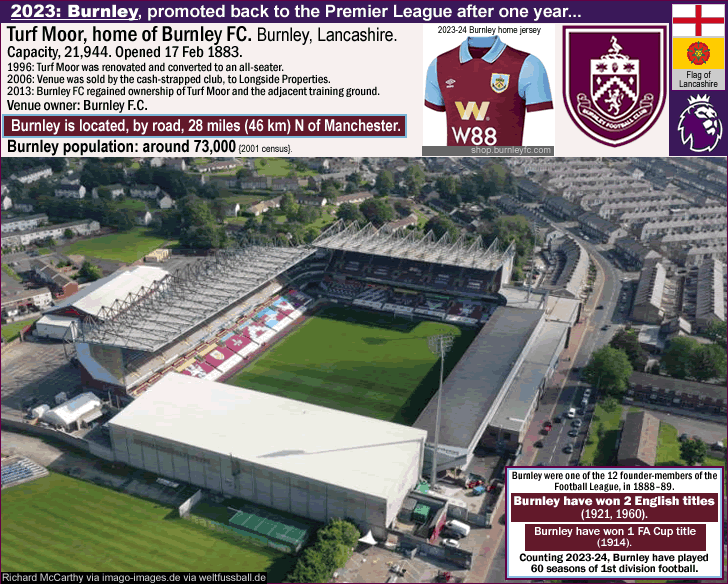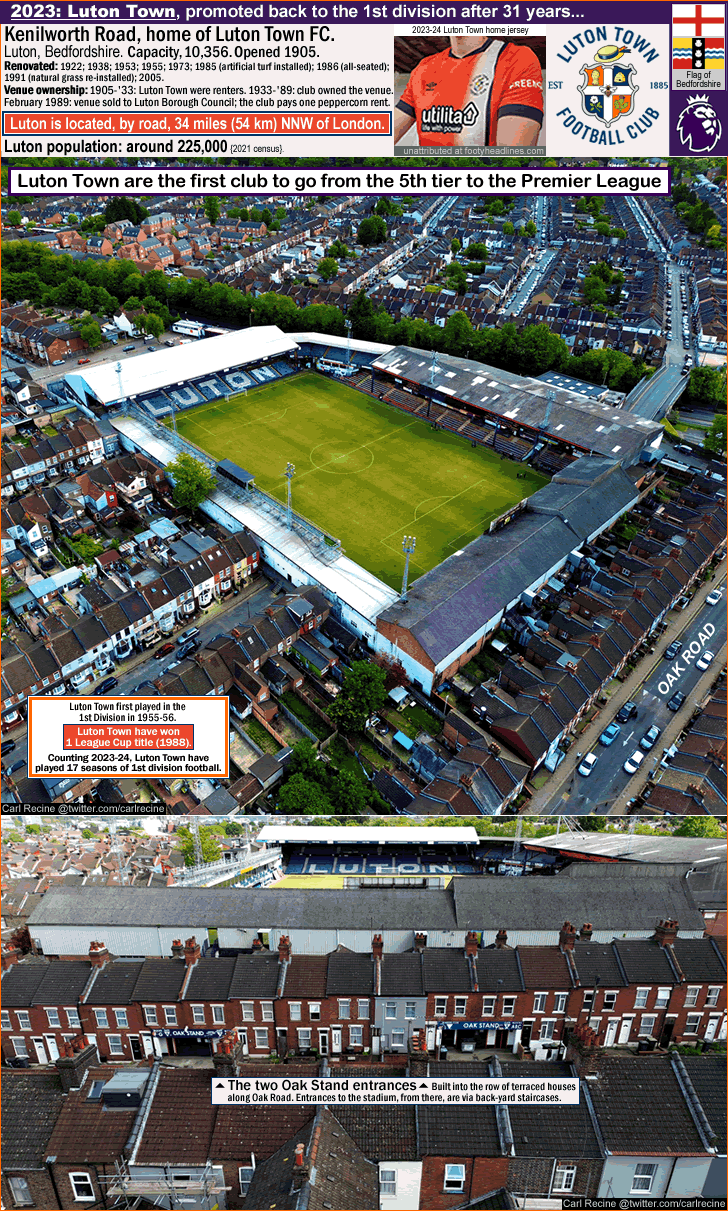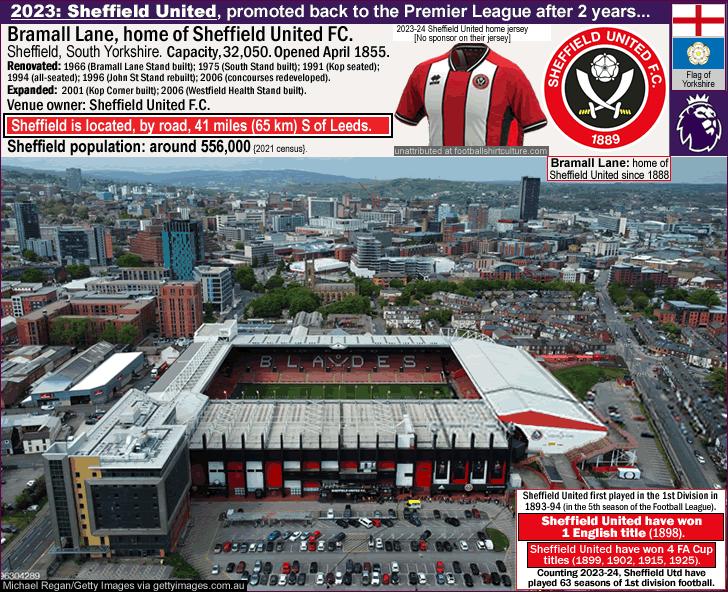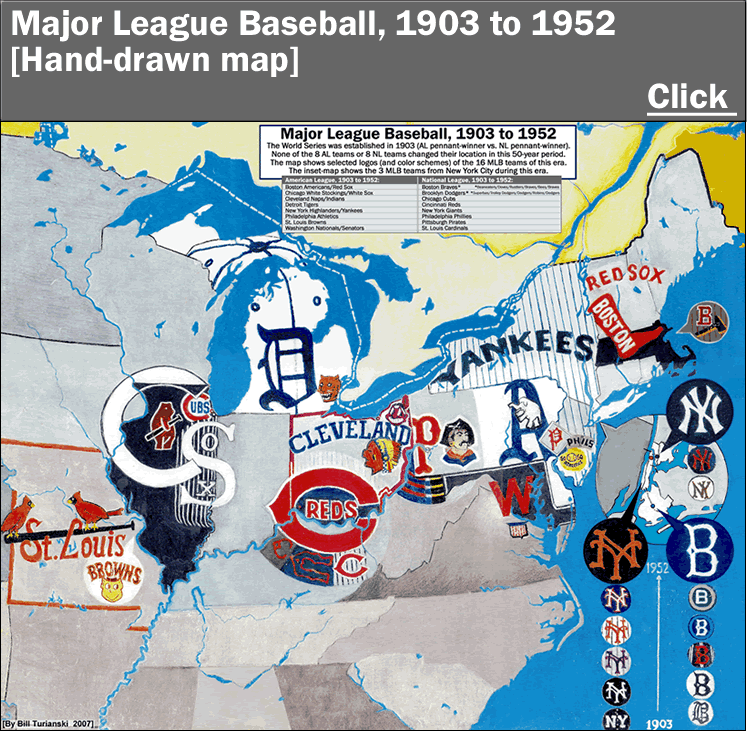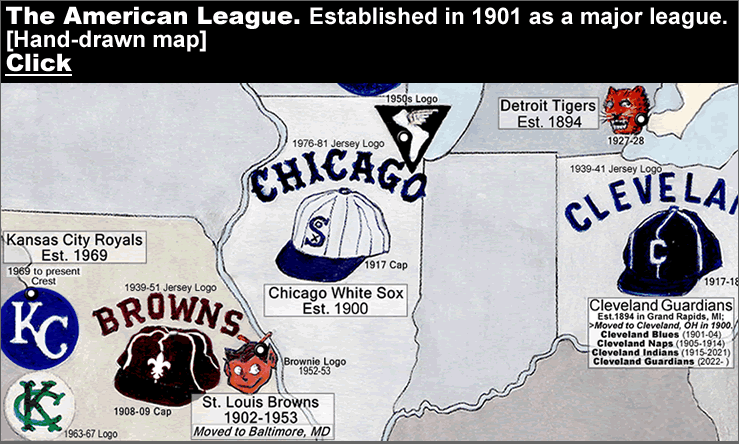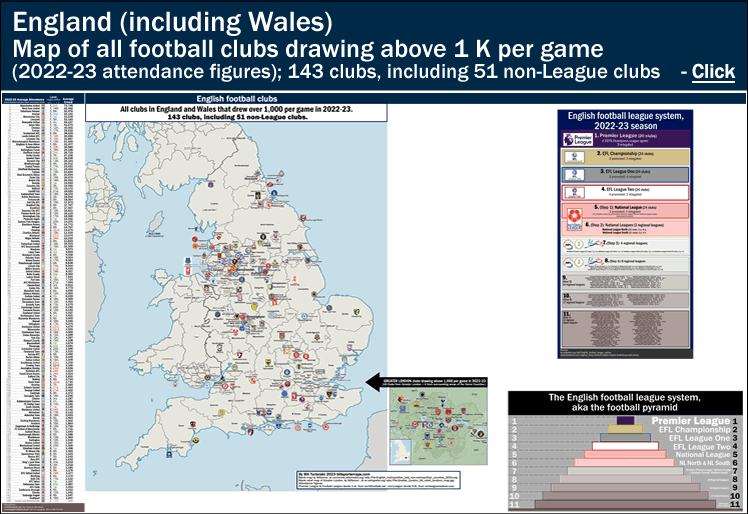
England (including Wales) – map of all football clubs drawing above 1,000 per game (2022-23 attendance figures): 143 clubs, including 51 non-League clubs
…
…
By Bill Turianski on the 30th of May 2023; twitter.com/billsportsmaps.
Sources…
-List of metropolitan areas in the United Kingdom (en.wikipedia.org).
-Metropolitan and non-metropolitan counties of England (en.wikipedia.org).
-Article on defining the largest cities in the UK.. Where are the largest cities in Britain? (citymetric.com).
Attendance figures…
-worldfootball.net. (Average attendances last season from the 1st division through 4th division.)
-nonleaguematters.co.uk. (Average attendances last season of all non-League clubs, ie from 5th division down.)
The map shows all clubs in the English football system which drew above 1,000 per game in 2022-23 (home domestic league matches): 143 clubs, including 51 non-League clubs. Also, there is an inset-map for all the clubs drawing above 1-K-per-game from Greater London-plus-the-immediate surrounding area (18 clubs from Greater London + 4 clubs from surrounding areas of the Home Counties).
On the left-hand side of the map-page, the clubs are listed by average attendance, along with a column showing 4 things: A) 2022-23 League-level; B) 2022-23 league-finish; C) Champions League Group Stage qualification [for the top 4 teams in the Premier League] (text in blue); D) promotion-or-relegation, if applicable (text in green for promotion / text in red for relegation).
On the right-hand side of the map-page are 2 charts showing the English football league system, aka the Pyramid. {See this, English football league system (en.wikipedia.org).}
(Note: in bold-17-to-36-point-type, on the map, are listed the 9 largest cities within England (all English cities with more than .6 million inhabitants…Greater London, Manchester, Birmingham, Leeds, Liverpool, Newcastle, Nottingham, Sheffield, Bristol). Also, in 12-to-15-point-type, on the map, are listed the 83 Metropolitan and non-metropolitan counties of England. Also, in 14-point-all-cap-bold-type, are listed prominent British regional names such as: the East Midlands, the West Midlands, East Anglia, the West Country, and the Lake District; as well as North Wales and South Wales.)
…
…
(Note: historical attendance figures noted below are from European-Football-Statistics.co.uk/[England non-League]. League histories noted below from FCHD.info.
There were 143 clubs which drew above 1,000 per game in 2022-23, plus I added one club to the map which drew 12-per-game shy of that mark (Havant & Waterlooville FC, of Hampshire). I included Havant & Waterlooville because there are almost always slight discrepancies in attendance figures from source to source, especially in non-League football, and 988 per game is just too close to one thousand to leave them off the map.
Of the 143 clubs that drew above 1-K-per-game last season, 5 are clubs which were not drawing above 1-K-per-game in the last three seasons of full attendance. Three of those 5 clubs, to the best of my knowledge, had never drawn above 1-K-per-game before last season (AFC Totten, Halesowen Town, Tonbridge Angels). Below are short profiles of those 5 clubs.
-(Note: on my corresponding map from the previous season [2021-22], I did the same thing, and profiled 11 clubs which similarly had not been drawing above 1-K-per-game; you can read about them at the following link,
England (including Wales, and Isle of Man) – map of all football clubs drawing above 1,000 per game (2021-22 attendance figures): 143 clubs, including 51 non-League clubs.)
• AFC Totton. From Totton, Hampshire (population: around 28,000), located just east of the New Forest, and located (by road) 5.3 mi (8.5 km) W of Southampton city centre. AFC Totton wear an all-blue kit, and are nicknamed the Stags. Since 2011, AFC Totton have played at Testwood Stadium (capacity 3,000; 500 seated). In 2007-08, Totton were winners of the Wessex Premier League (in the 9th level), and were promoted into the Southern League system, where they have remained to this day. In 2008-09, AFC Totton joined the Southern League Division One South & West; they drew 305 per game that year. Two years later (2010-11), Totton drew 330 per game and won the division, and were promoted to the Southern League Premier (7th level). The next season (2011-12), Totton reached their highest league-placement, finishing in 3rd in the Southern Premier, drawing 442 per game (their best average attendance at the time). After 3 seasons in the Southern Premier, in 2013-14 Totton fell back down to the Southern League D-1 South & West. Totton remained in the Southern League’s lower divisions for the next 9 years (7 seasons, plus the 2 COVID-abandoned seasons). For 7 straight seasons, from 2014-15 up to the first-COVID-abandoned season of 2019-20, Totton were only drawing in the high-200s-per-game. That changed in 2021-22, when Totton finished in 6th in the Southern D-1 South, drawing a division-best 535-per-game. And then in the following season of 2022-23, Totton won the Southern D-1 South by 7 points, and doubled their average attendance, drawing 1,107 per-game. {See this from 16 April 2023: AFC Totton win Southern League Division 1 title with win over Exmouth Town (advertiserandtimes.co.uk/sport).} So, for 2023-24, after an absence of 9 years, AFC Totton returns to the upper level of the Southern League [the Southern League has two upper divisions these days]. For 2023-24, Totton will play in the Southern Premier South, as the division’s highest-drawing club.
• Halesowen Town FC. From Halesowen, West Midlands (population: around 60,000), located (by road) 9.5 mi (15 km) WSW of Birmingham city centre. Halesowen Town wear blue jerseys, and have the steeple of the Norman-era parish church of St John the Baptist, Halesowen on their badge. Halesowen Town are, somewhat mysteriously, nicknamed the Yeltz. {See this: The Origin of Yeltz (yeltzland.net).} Since 2012-13, Halesowen Town have changed league-systems 3 times: they have been shuttled back and forth, and then back again, between northern- and southern-based leagues. Nine years ago (2013-14), Halesowen drew 345-per-game, as the Northern Premier League D-1 South champions, and were promoted to the Northern League Premier (in the 7th level). Four seasons later, in 2018, Halesowen were relegated back down to the 8th level, and the club was also transferred – to the Southern League system, into the Southern League D-1 Central (as part of the restructuring of the non-League pyramid that year.) Halesowen almost got relegated again, the next season (2018-19), finishing in 21st place. But then in the COVID-abandoned season of 2019-20, Halesowen had rebounded, and were in 2nd place when matches were stopped in March of that dire year; they were averaging 534 per-game that abandoned season. After the next COVID-abandoned season of 2021-22, Halesowen Town were transferred to a new league again, back to the Northern League system, into the Northern League D-1 Midlands (still in the 8th level). The next season (2021-22), Halesowen finished in 3rd place, 4 points back, and drew a solid 968 per-game (an attendance increase of over 400 per game). Last season (2022-23), Halesowen Town continued their good run, and finished in 2nd, 9 points back, and finally surpassed the one-thousand-per-game mark, with an average crowd of 1,087. And in the Northern D-1 Midlands play-offs in April 2023, Halsowen won promotion, by beating Coleshill Town 3–1 in the semi-finals, then beating Spalding United in the final [2–1 aet]. That play-off final, on 29 April, was at Halesowen Town’s ground, The Grove, and there were 3,250 in attendance. {See this: Gallery: Halesowen win promotion in extra time thriller (expressandstar.com/sport).} And so for 2023-24, after 6 years elsewhere, Halesowen Town are now back again in the Northern Premier, and the Yeltz will almost certainly draw better than 1.0-K-per-game.
• Eastbourne Borough FC. From Eastbourne, East Sussex (population: around 101,000), located (by road) 25 mi (40 km) E of Brighton; and located (by road) 84 mi (135 km) S of central London. Eastbourne Borough wear red-&-black and are nicknamed the Sports. Eastbourne Borough’s crest features a depiction of a Martello Tower, ‘one of a large number of coastline fortifications along the South Coast, dating from the Napoleonic Wars in the early 19th Century’ {text from FootballCrests.com/[Eastbourne Borough FC]. Eastbourne Borough were founded in 1964 as Langney FC, naming themselves after the Langney district of Eastbourne where they played. In 1983, the club moved into their present-day home, Priory Lane, in the residential north end of Eastbourne. In 2000, Langney FC were promoted as champions of the Sussex League (in the present-day equivalent of the 9th level). So Langney FC joined the Southern League system in 2000; they changed their name to Eastbourne Borough in 2001. Eastbourne Borough won promotion to the Southern League Premier in 2003. They finished in 11th place the following season (2003-04), and that was good enough for promotion into the newly-formed Conference South. {See this, 2004-05 Football_Conference (en.wikipedia.org).} In their fourth season in the 6th level they were promoted, by winning the 2007-08 Conference South play-offs. Eastbourne Borough played three seasons in the Conference (5th level), before being relegated back to the 6th tier in 2011. And that is where Eastbourne Borough have remained for the past 12 years. Eastbourne were drawing in the 500s (as a 7th tier side) circa 2003; as a 6th-tier side, they were drawing between 600 and 720-per game for 3 seasons, then drew 872 per game in 2007-08, when they won promotion to the 5th tier. The next season (2008-09), the newly-promoted Eastbourne first broke the one-thousand-per-game mark. In their 3 seasons of 5th division football (2008 to 2011), Eastbourne drew 1.3-K-, 1.2-K-, and 1.1-K-per-game. In 2012, after the club’s relegation back to the 6th tier, crowds dropped by almost 450-per-game. And then, as a lower-mid-table side, their crowd size was in the 500-580-per-game range for 7 seasons (2013 to 2020). Then, in 2021-22, with the return of non-League football after COVID restrictions were lifted, Eastbourne’s attendance at Priory Lane shot up 77 percent: they finished in 6th place, and drew 969 per game. And in 2022-23, Eastbourne, as an 8th place finisher, drew 5 percent better, at 1,053 per game.
• Tonbridge Angels FC. From Tonbridge, Kent (population: around 41,000), located (by road) 42 mi (67 km) SE of central London. Tonbridge FC were formed in 1947; their ‘Angels’ nickname has been used by fans since the early 1950s, but was not formally adopted by the club until 1994. Tonbridge Angels wear blue-and-white; since 1980, they have played at Longmead Stadium (cap. 3,000; 720 seated). A year after their formation, in 1948, Tonbridge FC joined the Southern League. And with the exception of 4 seasons in the early 1990s, when they played in the Kent League, the club remained in the Southern League system for 53 years (1948-1989; 1993-2004). In 2004-05, Tonbridge were transferred to the Isthmian League Premier. They were relegated to the Isthmian D-1 the next year, but bounced straight back to the Isthmian Premier in 2006, where they stayed for 5 seasons, before winning promotion via the play-offs in 2010-11, drawing 448 per game. In 2011-12, as a 6th-tier-side for the first time, Tonbridge drew 663 per game. Tonbridge lasted 3 seasons in the 6th tier, before relegation back to the Isthmian League in 2014. 5 years later, in 2018-19, they won promotion back to the 6th tier, drawing 542 per game. In their next three seasons, in the National League South, Tonbridge saw a gradual attendance rise: 607 per game in the COVID-abandoned season of 2019-20; 827 per game in 2021-22, when non-League football re-opened, and Tonbridge finished in 16th place; and 1,047 per game last season in 2022-23, when Tonbridge Angels finished in 9th place. In Tonbridge Angels, one can see the larger overall trend of post-COVID increase in non-League football attendance. Because between 2019 and 2023 (3 seasons), Tonbridge Angels had a 400-per-game attendance increase – from 600-per-game to 1,000-per-game, yet the team remained a 6th-tier mid-table side which only improved 6 league-places. In late April 2023, Tonbridge Angels changed their crest. {See this, Tonbridge Angels leaves fans split after revealing their brand new crest (fanbanter.co.uk).}
• Southport FC. From Southport, Merseyside (population: around 91,000), located (by road) 20 mi (32 km) N of Liverpool city centre. Southport wear amber-and-black, and are nicknamed the Sandgrounders. Since 1905, Southport have played at Haig Avenue (capacity 5,414; 1660 seated [previous capacity: 6,008]). In 1921-22, Southport were a founding member of the Football League Division Three North. Back then, the club was drawing in the 5-K per game range. {See this, Southport FC attendance history at European-Football-Statistics.co.uk.} Their attendance peak was in 1947-48 (the second season after the return of pro football following the end of World War II), when Southport drew 8.0-K per game. Southport played 39 successive seasons of 3rd-tier-North football (1921 to 1958). After finishing second from last in 1957-58, they were re-elected – but sent down (with the eleven other clubs in the bottom half of the table) into the new Football League Division Four. Around this time, Southport were drawing in the mid-3,000s. In 1966-67, Southport finished in 2nd place, and were promoted back to the 3rd tier, drawing 5.2-K per game. They were relegated back 3 years later in 1970. Three years later they won promotion again, and to this day, the club’s main honour is winning the 1972–73 Football League Fourth Division title. But they went straight back down to the 4th tier the following season. And it got worse: in 1978, after 3 out of 4 seasons finishing second-to-last, and after drawing only in the 1.4-K-to-1.9-K-range for those four years, Southport lost re-election and were voted out of the Football League. Southport played 50 seasons in the Football League. Since then (1978-79), Southport have been a non-League team. Their highest league-placement since expulsion from the League was in 2000-01, when they finished in 4th place in the Conference (5th level), drawing 1.4-K per game. The last time they were in the 5th division was in 2016-17. In the second decade of the 2000s, Southport drew between 0.9-K and 1.4-K per game. Last season, despite finishing in 18th place in the National League North, Southport managed to draw slightly over 1-K per game.
…
___
Thanks to all at the links below…
-Blank map of English Metropolitan and Non-Metropolitan Counties, by Nilfanion, at File:English metropolitan and non-metropolitan counties 2010.svg (commons.wikimedia.org).
-Blank relief map of Greater London, by Nilfanion (using UK Ordnance Survey data), at File:Greater London UK relief location map.jpg.
-English football league system (en.wikipedia.org).
Attendance…
-worldfootball.net (1st division through 4th division).
-nonleaguematters.co.uk (all non-League from 5th division down).
